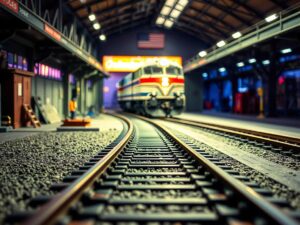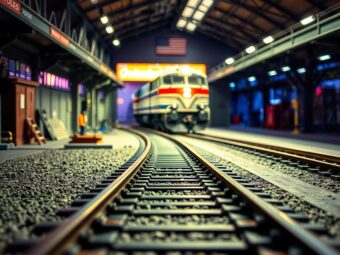
Getting Started with HO Scale Trains for Beginners
Welcome to the wonderful world of model railroading! Whether you’re drawn to the intricate details, the satisfying clickety-clack of trains on track, or simply the joy of creating your own miniature worlds, there’s a place for you in this hobby. And one of the most popular and accessible scales is HO scale.
This beginner’s guide will walk you through everything you need to know about HO scale model railroads, from understanding the basics to setting up your first layout. Let’s dive in!
What is HO Scale?
HO scale stands for “Half O,” referring to a specific measurement of 1:87. This means that every inch on your model train track represents 87 inches in real life. It’s the most popular scale for model railroading, offering a balance between realism and affordability.
Why Choose HO Scale?
- Accessibility: HO scale is readily available at hobby stores and online retailers. You can find everything from basic starter sets to highly detailed locomotives and rolling stock.
- Versatility: HO scale allows you to build layouts of various sizes, from small tabletop layouts to sprawling multi-room scenes.
- Community: The HO scale community is vibrant and welcoming. There are countless online forums, clubs, and conventions where you can connect with fellow enthusiasts.

HO Scale Model Trains: A Beginner’s Guide
Before you start building your first layout, let’s talk about the essential components of an HO scale model train set:
Locomotives: The heart of your train fleet! Choose from a variety of manufacturers like Bachmann, Lionel, Atlas, and more.
- Types: Diesel locomotives, steam engines, passenger cars, freight cars – there’s a locomotive for every theme and era.
- Features: Look for features like working couplers, lights, sound effects (for some models), and detailed paint schemes.
Rolling Stock: The essential cargo of your train! Choose from boxcars, tankers, gondolas, passenger cars, and more to complete your fleet.
- Types: Each car has a specific purpose, so consider what types of freight you want to represent on your layout.
- Features: Look for details like working doors, ladders, and realistic markings.
Track: The foundation of your layout! HO scale track comes in various configurations:
- Straight Track: For basic layouts or sections of a larger scene.
- Curves: Add curves to create more dynamic and interesting tracks.
- Turnouts: These allow you to switch between different tracks, creating complex routes for your trains.
Power Supply: The engine that drives your train! Choose from DC (Direct Current) or AC (Alternating Current) power supplies.
- DC: Simpler and more affordable, but may require a separate transformer.
- AC: More powerful and efficient, but can be more expensive.
Setting Up Your First HO Scale Layout
Choose a Location: Find a space that’s large enough for your layout and allows you to work comfortably. Consider:
- Space: How much room do you have?
- Lighting: Will there be adequate lighting for viewing your model trains?
- Accessibility: Is it easy to access and maintain your layout?
Plan Your Layout: This is where creativity comes in! There are endless possibilities:
- Theme: Do you want a realistic representation of a specific railroad or a fictional world?
- Size: How big do you want your layout to be?
- Features: Will there be hills, tunnels, bridges, and other scenic elements?
Build Your Track: HO scale track is available in various lengths and configurations. You can use pre-made sections or create custom layouts using individual pieces.
- Track Planning Software: Tools like Trainz or Railworks can help you plan your layout before building it.
Add Scenery: Enhance the realism of your layout with scenery elements:
- Trees and Buildings: Create a sense of depth and scale.
- Ground Cover: Add texture to your trackbed.
- Water Features: Lakes, rivers, or even miniature ponds can add visual interest.
Advanced Tips for HO Scale Model Railroaders
- Join the Community: Connect with fellow model railroad enthusiasts online or in person.
- Experiment with Lighting: Add realistic lighting to your layout using LED lights or other illumination techniques.
- Learn about DCC (Digital Command Control): This technology allows you to control multiple trains and features remotely, adding a new level of realism and fun to your hobby.
HO Scale Model Railroading: A Journey of Passion and Creativity
Model railroading is more than just building a train track; it’s an art form that combines creativity, technical skill, and a passion for the hobby. Whether you’re a seasoned modeler or just starting out, there’s always something new to learn and explore in this fascinating world.
Useful Insights for HO Scale Model Railroad Enthusiasts
- Start Small: Don’t feel pressured to build a massive layout right away. Start with a simple tabletop layout and gradually expand as you gain experience.
- Research Your Options: There are countless resources available online, in books, and at hobby stores. Take advantage of these resources to learn about different brands, models, and techniques.
- Have Fun! Model railroading is a rewarding hobby that can bring joy for years to come. Enjoy the process, experiment with different ideas, and let your creativity run wild!
Useful Insights for HO Scale Model Railroad Enthusiasts
- Start Small: Don’t feel pressured to build a massive layout right away. Start with a simple tabletop layout and gradually expand as you gain experience.
- Research Your Options: There are countless resources available online, in books, and at hobby stores. Take advantage of these resources to learn about different brands, models, and techniques.
- Have Fun! Model railroading is a rewarding hobby that can bring joy for years to come. Enjoy the process, experiment with different ideas, and let your creativity run wild!
I hope this guide has provided you with a solid foundation for getting started with HO scale model railroads. Remember, there’s no right or wrong way to do it – just have fun and enjoy the journey!








